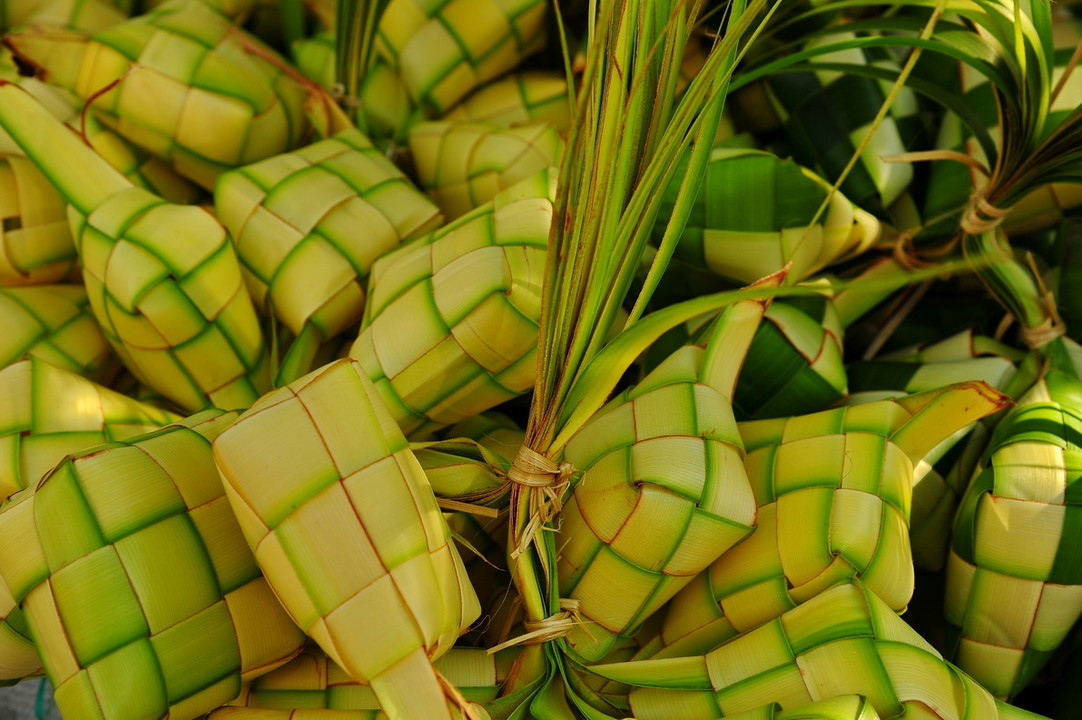
The Historical, Cultural and Religious Significance of the Ketupat
Stumbled upon an interesting Facebook post which attempts to detail some of the little known facts about the ketupat, and I honestly felt that it should gain more attention especially in this day and age where our culture is undergoing a massive erosion. Really peaked my curiosity and managed to uncover even more interesting historical facts about our favourite Hari Raya food item.
1. History
The history of the ketupat predates the coming of Islam into the Nusantara, and there are evidence that a particular form of rice cakes, not unlike the ketupat, were used by local pre-Hindu, pre-Islam devotees as offerings to Dewi Sri, the goddess of rice and fertility (similar scenes can still be observed in Bali). Rice, as a staple food, remains an important aspect in the lives of the indigenous Southeast Asian people, also reflected in its art and architecture.
Rice cake offerings at Goa Gajah Temple, Bali, Indonesia. Source: https://www.trover.com/d/eJPJ-goa-gajah-blahbatuh-indonesia
2. Sunan Kalijaga (Raden Sa’id Abdurrahman)
One of the revered Islamic saints of the Wali Songo, the significance of the ketupat as a local religious tradition during Eidul Fitr is largely attributed to him, and this was even recorded in the Sulalatus Salatin (Malay Annals). Sunan Kalijaga, being highly influenced by Sufism, employed a more artistic and cultural approach towards dakwah. Through this individual, the association of the ketupat to Dewi Sri was slowly abolished, and newer meanings were ascribed to each individual element of the ketupat (elaboration below).
3. Fasting in the 6 days of Syawal
Interestingly enough, Sunan Kalijaga also promoted the 8th day of Syawal as the Bakda Kupat, and it is on this day that the ketupat is widely consumed as a celebratory food item. This is in line with the common Islamic tradition of fasting on six days of Syawal, as per the Sunnah of the Prophet (pbuh). In the Malay Peninsula especially, there is also a common practice of clearing the six days of fasting within the first week of Syawal (2nd to 7th), and having what is known as Raya Enam (on the 8th of Syawal), a tradition that seemingly has stayed consistent throughout the years.
4. Etymology, Act of Forgiveness
The word ketupat (kupat) can be said to be a condensation of the phrase ‘ngaku lepat’, which is translated as acknowledging your own mistakes. No surprises there, for Hari Raya even until today is synonymous with the act of asking for forgiveness for our many mistakes. This is embodied in the act of sungkem, a Javanese term for when children asks for forgiveness from their parents and elders. The ketupat itself is also said to be presented to the elders by the younger generation.
Sungkeman as observed during a wedding ceremony. Source: https://cahyono84.wordpress.com/2010/03/14/wedding/attachment/15/
5. Other Symbolic Representations
The difficult weaving process of the ketupat symbolizes the problematic nature and complexity of humans who constantly err and sin, and this is shown as the outer layer of the ketupat. However, when cut open, the white insides of the rice cake symbolizes the purity of the heart after a month of fasting during Ramadan. The young coconut leaves used to weave the ketupat are called janur, and this is derived from the phrase ‘jatining nur’, which also means the ‘pure heart’. The intricate weaving pattern can also be said to be representative of silaturrahim, a form of communal trust, friendship and camaraderie which is celebrated both in Malay culture as well as Islamic traditions.
Conclusion
Evidently, there are even more interesting nuggets of information that I can only hope to digest (along with the ketupat). This narrative only covers the area of Java, and while it may be applicable to us, I’m pretty sure there are also unique and fascinating stories about the different variations of ketupat in the Nusantara, such as the burasak, lontong, lemang, lepat, puso and so on. These forms of cultural heritage should be given more awareness and preserved, and this is a perfect example of how Islamic traditions can be adapted and modified to exist alongside the Malay culture.
Oh, and Eid Mubarak everyone! Remember to share the story of the ketupat with your friends and family, rather than just devouring it endlessly!


Educator
5yWonderful! No wonder Malaysians are more fond of Lemang than Ketupat!